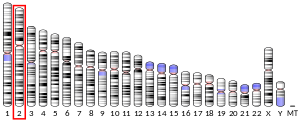
Erythroferrone

151176227358ENSG00000178752ENSMUSG00000047443Q4G0M1Q6PGN1NM_152521NM_001291832NM_173395NP_001278761NP_775571Erythroferrone is a protein hormone, abbreviated as ERFE, encoded in humans by the FAM132B gene. Erythroferrone is produced by erythroblasts, inhibits the action of hepcidin, and so increases the amount of iron available for hemoglobin synthesis. Erythroferrone is a protein hormone, abbreviated as ERFE, encoded in humans by the FAM132B gene. Erythroferrone is produced by erythroblasts, inhibits the action of hepcidin, and so increases the amount of iron available for hemoglobin synthesis. It was identified in 2014 in mice where the transcript was found in bone marrow, encoded by the mouse Fam132b gene. The homologous gene in humans is FAM132B and the sequence is conserved in other species. The protein is synthesized by erythroblasts and secreted. This sequence had previously been found expressed in mouse skeletal muscle, called myonectin (CTRP15), and linked to lipid homeostasis. Erythroferrone in humans is transcribed as a precursor of 354 amino acids, with a signal peptide of 28 amino acids. The mouse gene encodes a 340 amino acid protein which is 71% identical. Homology is greater at the C-terminal where there is a TNF-alpha-like domain. Erythroferrone is a hormone that regulates iron metabolism through its actions on hepcidin. As shown in mice and humans, it is produced in erythroblasts, which proliferate when new red cells are synthesized, such as after hemorrhage when more iron is needed (so-called stress erythropoiesis). This process is governed by the renal hormone, erythropoietin. Its mechanism of action is to inhibit the expression of the liver hormone, hepcidin. This process is governed by the renal hormone, erythropoietin. By suppressing this, ERFE increases the function of the cellular iron export channel, ferroportin. This then results in increased iron absorption from the intestine and mobilization of iron from stores, which can then be used in the synthesis of hemoglobin in new red blood cells. Mice deficient in the gene encoding erythroferrone have transient maturational hemoglobin deficits and impaired hepcidin suppression in response to plebotomy with a delayed recovery from anemia. In its role as myonectin, it also promotes lipid uptake into adipocytes and hepatocytes. Synthesis of erythroferrone is regulated by erythropoietin binding to its receptor and activating the Jak2/Stat5 signaling pathway. The clinical significance in humans is becoming clear. From parallels in the mouse studies, there may be diseases where its function could be relevant. In a mouse model of thalassemia, its expression is increased, resulting in iron overload, which is also a feature of the human disease. A role in the recovery from the anemia of inflammation in mice has been shown and involvement in inherited anemias with ineffective erythropoiesis, anemia of chronic kidney diseases and iron-refractory iron-deficiency anemia has been suggested.
